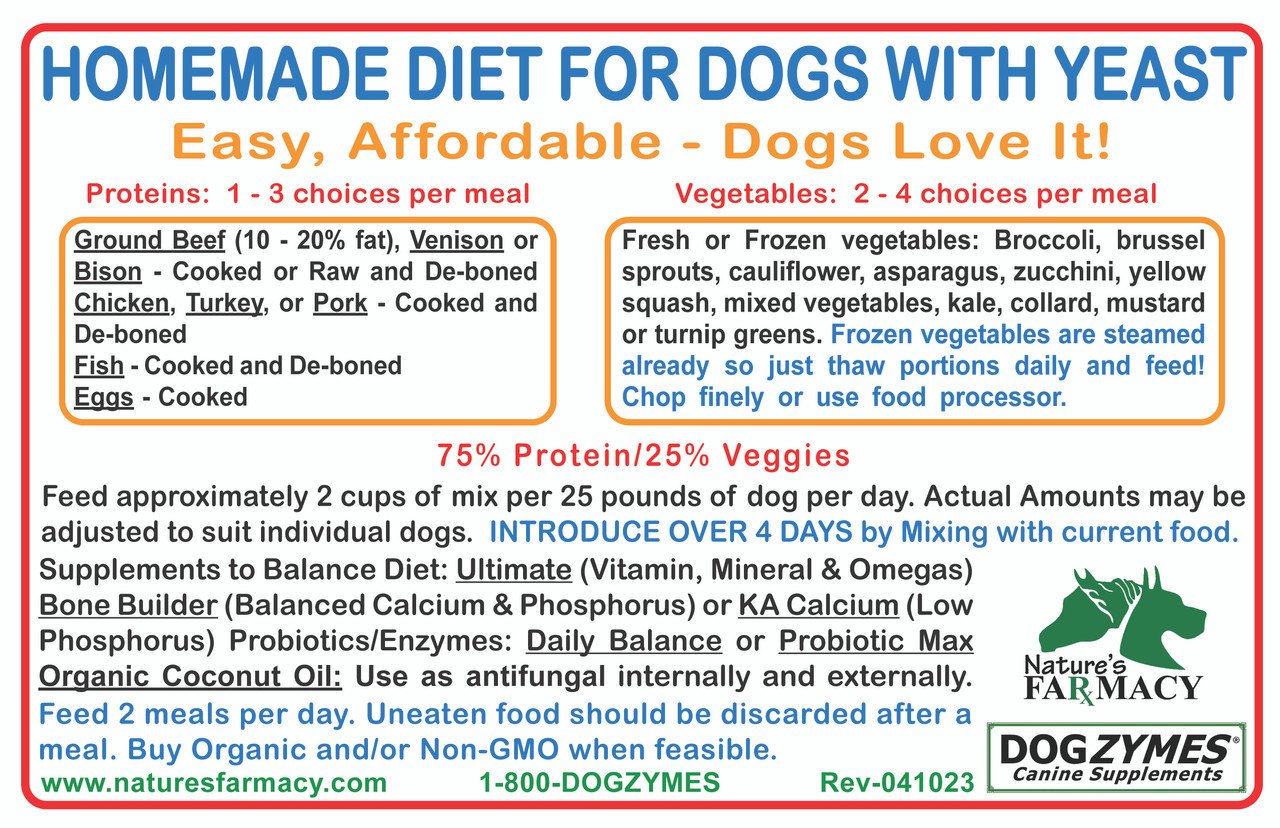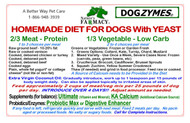Systemic Yeast Infections In Dogs by Nature's Farmacy, Inc.
20th Jan 2018

Nature’s Farmacy (Manufacturer of DogZymes Supplements)
Feb 15th 2014
A Systemic Yeast Infections in dogs, is a condition that occurs when yeast builds up in a dog’s body. This condition starts in the digestive system and is caused by a pH imbalance. During this imbalance harmful yeast that is normally present multiplies rapidly and systemically invades the body. During periods of pH imbalance and yeast invasion, more toxins are excreted from a dog’s lymph nodes causing excessive itchiness. The dogs will then lick or itch these “hot spots”. Although some dogs with systemic yeast infections may not exhibit any outward signs at all, most dogs will exhibit one or more of these symptoms:
The Yeast genus has over 1500 species and new strains are discovered every day. Some of these species are beneficial and some are detrimental to Canines. Unfortunately, when testing for a yeast infection, those with limited microbiological backgrounds quickly assume these infections are all caused by the Candida albicans species of yeast. When Candida albicans is not found, they disregard Yeast Invasion as a cause for the symptoms and blame these symptoms on non-existent allergies or fleas. In most cases they simply use antibiotics. Antibiotics will kill all beneficial bacteria in the gut prolonging the pH imbalance and the yeast infection.
At Nature’s Farmacy we have been assisting breeders and owners with animals suffering from systemic yeast infections for over 25 years. Our approach is simple: Start at the source and work from the inside out. Most systemic yeast infections start from feeding grain based dog foods. Grain ferments in a dog’s stomach causing pH levels to change and create an environment that is more hospitable to negative yeast and bacteria than beneficial yeast and bacteria. Aside from the pH level, a healthy Canine digestive system is a perfect environment for negative yeast. Once the fermentation process causes pH imbalance, negative yeast will quickly begin to thrive and cause a rapid, systemic yeast infection. Simple diet changes, such as switching to a raw diet (link to diet) or feeding a grain free dog food and grain free treats, will eliminate the cause of the infection and allow recovery to begin. Remaining on a grain based dog food or feeding grain based treats will allow bad yeast to continue to thrive and can hinder or halt recovery. Most pathogenic yeast species thrive on carbohydrates and sugars. It is a common misconception that dogs use carbohydrates for energy so most dog foods contain them. Dogs actually will naturally use high quality fats, like those found in meat, for energy. A carbohydrate/sugar free diet is a must for dogs recovering from systemic yeast infections. Removing carbohydrates and sugars from the dog’s diet will make the food supply of most pathogenic species of yeast more scarce which will help to discourage new colonies and weaken existing ones so they can be more easily purged. Unfortunately, very few commercially available processed dog foods meet these requirements. There are no standards for the quality of dog food (as dogs are not food producing animals) and they can contain very poor quality ingredients. It is much easier and usually cheaper to feed a modified raw diet that consists of meat and vegetables. Feeding a homemade diet isn’t nearly as difficult as you might think and you will have peace of mind of knowing that your dog’s food meets human quality standards. You can learn how to feed your dog a diet of fresh, real food by reading Nature’s Farmacy’s free User Friendly Diet For Dogs and cats With Yeast Infections. Please feel free to contact one of our qualified dieticians for assistance.
The seconds step is to crowd out the negative bacteria. A dog’s body has a limited amount of space for colonizing yeast and bacteria. Bombarding the animal’s body with beneficial bacteria and yeast cultures will crowd out the negative ones and in many cases, even consume them. Crowding out the negative bacteria and yeast with positive species will also help to speed the correcting of the pH levels as more digestion-friendly species begin to colonize and start competing for food physical room. To jump-start purging of systemic yeast pathogens and pH correction you will need a microbial product with high counts colony forming units of beneficial species of both bacteria and yeast, such as Nature’s Farmacy DOGZYMES Digestive Enhancer or Liquid Dispersible Digestive Enhancer. Initially, we recommend feeding double the usual suggested feeding rate to ensure colonization during this critical jump-start period. After the systemic yeast infection has been purged you may return to the normal suggested rate.
A useful third step is to kill the yeast in the skin. The medium chain fatty acids in our Organic Hawaiian Coconut Oil (Caprylic, Capric, and Lauric Acid) all work together to kill most common types of systemic yeast. In fact, many common prescription treatments for yeast infections are derived from coconut oil. The medium chain fatty acids travel throughout the skin killing systemic yeast that the Digestive Enhancer has pushed out of the inner body leaving nowhere for the yeast to thrive.
The fourth step is to treat the external outbreaks of systemic yeast infections. In standard veterinary practice, most of the time this is the first or only part treated. Treating external symptoms without treating the underlying cause rarely works and symptoms quickly return when topical treatment is stopped. Please understand that topical treatments are only intended to provide relief for the animal’s symptoms. For topical outbreaks of most species systemic yeast, bacteria, or other fungi, we have found success using our topical bacteriocin, Clora-Care. The active ingredient in Clora-Care, Ambicin N, discriminates between harmful bacteria and healthy skin which allows the product to be gentle on the dog and aggressive on negative bacteria, yeast, and fungi. Clora-Care can kill negative pathogens and provide relief in as little as 15 seconds and can hold its killing power for up to 12 hours. Please note that Clora-Care will leave a harmless, temporary blue hue to the skin and hair. When treating “yeasty ears” it is important to clean them before applying Clora-Care. Use Nature’s Farmacy Easy Ear (An all Natural Essential Oil Blend) to thoroughly clean all debris from the ear. Easy Ear is formulated to gently lift the debris from the inner and outer ear. It removes the earwax while nurturing the ear skin to promote faster healing.
It is important to understand that there are no shortcuts when dealing with a systemic yeast infection. Failure to remove the source of the infection can prolong it indefinitely. Many dogs may never be able to return to a typical commercial diet of grain/carbohydrate based dog food without experiencing a recurrence of yeast invasion.
• Abnormal body odor
• Licking or chewing of feet, legs, groin, tail-head
• Excessive Itchiness
• Pustules on the body (hives/pimples)
• Redness, staining between toes
• Oily yet flaky skin

